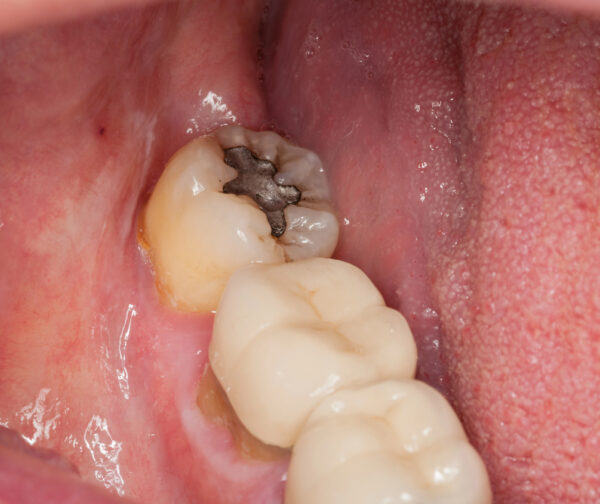The European Union’s recent decision to ban mercury dental amalgams is an important step towards prioritizing health in dental practices. This landmark ban takes effect on January 1, 2025, and is an important step towards safeguarding European patients from health risks associated with mercury amalgams – aka silver fillings.
Why this is a big deal
The silver dental fillings many Americans have in their mouths contain approximately 50% mercury which leaches out into the body every time you chew, eat or drink (especially when eating or drinking something hot), in the form of mercury vapor. According to peer reviewed literature, there is no known safe level of mercury.[1] When these silver fillings are placed, or if removed without proper precautions, there is additional exposure to the patient, the dentist, the dental technicians and anyone else present in the office.
It is estimated that 2-20 micrograms pf mercury per day are released from a filling during chewing.[2] With large or damaged fillings we would expect more mercury to be released. Often people will have more than one filling in their mouth – Some of my patients have 4-6 of these fillings. The Mayo Clinic lab guide for mercury testing states that the World Health Organization safety standard for daily exposure to mercury is 45 mcg/day, so if you do the math for someone with 6 large silver fillings, the daily dose of mercury clearly exceeds the WHO safety standard:
6 fillings x 20 mcg/day = 120 mcg
Mercury is toxic
Mercury is neurotoxic and nephrotoxic (damages the nervous system and the kidneys). Common symptoms and issues associated with mercury exposure include tremors, insomnia, headaches, nerve damage, kidney problems and respiratory issues. Mercury is also implicated in many forms of cardiovascular disease, including high blood pressure, heart attack, stroke and vascular disease.[3] The amalgam product label itself states that ingestion may cause neurotoxic and nephrotoxic effects and that acute exposure may cause sensitization dermatitis and possible visual disturbances, yet these fillings are still used in many countries including in the US and Canada. Awareness of the issue is, however, growing rapidly.
High risk populations for amalgam use
Despite the clear evidence that mercury is a toxin, there continues to be significant resistance among US and Canadian health stakeholders to acknowledging the existence of adverse effects from mercury amalgams. In the US, however, there has been recent recognition that certain populations are at greater health risk from placement of mercury amalgams. The FDA recognizes that the following groups of people are more susceptible to potential adverse effects associated with mercury amalgams and should use non-amalgam fillings (such as composite resins).[4]
- Pregnant women and their developing fetuses
- Women who are planning to become pregnant
- Nursing women and their newborns and infants
- Children, especially those younger than six years of age
- People with pre-existing neurological disease
- People with impaired kidney function
- People with known heightened sensitivity (allergy) to mercury or other components (silver, copper, tin) of dental amalgam.
Take home messages
Mercury is a toxin associated with a wide variety of adverse health effects. The longer the fillings are present, the greater the absorption of mercury into the body and the greater the body burden.
If you have silver fillings in your teeth, the first step is to get educated about the potential effects of chronic mercury exposure. Removal of amalgams may not be appropriate for everyone and should be discussed with a dentist and health practitioner who understands the health effects of mercury.
If you opt to have the fillings removed, be sure to have the removal done by a biological dentist who uses mercury safe dental practices. You can find a local expert on the IOMAT website (International Academy of Oral Medicine and Toxicology).
If you have any concerns or questions about mercury amalgams and your health, don’t hesitate to reach out for a consultation.
Sharon Goldberg is a Santa Fe based Integrative and Functional Medicine Physician who specializes in personalized preventive and wellness focused patient care. She is Board Certified in Internal Medicine since 2000 and has advanced training in Tropical Medicine and Hygiene. She has over two decades of practice experience working with both complex chronic illness and disease prevention. She is a medical educator, peer reviewer and coauthor of integrative and prevention related clinical research.
Sign Up for Updates
The information provided on this site www.drsharongoldberg.com is for informational purposes only. Dr. Sharon Goldberg and Glow Health, PA assume no responsibility and make no claims in treatment or cure of any disease or illness. The information provided by www.drsharongoldberg.com is not intended to substitute for medical advice from your physician or healthcare professional and is intended to support, not replace, the relationship that exists between a patient/site visitor and his/her physician. If you have/suspect you might have a health problem, you should consult your medical doctor. Supplements can interact with prescription medications. Be sure to consult with a healthcare professional before starting any diet, exercise, or supplement.
[1] Houston, Mark C. “Role of mercury toxicity in hypertension, cardiovascular disease, and stroke.” The Journal of Clinical Hypertension 13.8 (2011): 621-627.
[2] https://www.fda.gov/medical-devices/dental-devices/dental-amalgam-fillings#resources
[3] Bose-O’Reilly, Stephan, et al. “Mercury exposure and children’s health.” Current problems in pediatric and adolescent health care 40.8 (2010): 186-215.
[4] https://www.mayocliniclabs.com/test-catalog/overview/8618#Clinical-and-Interpretive



Leave a Reply